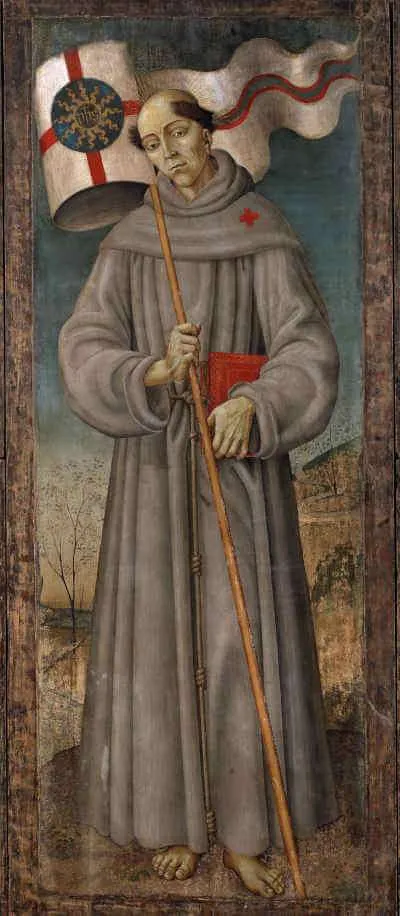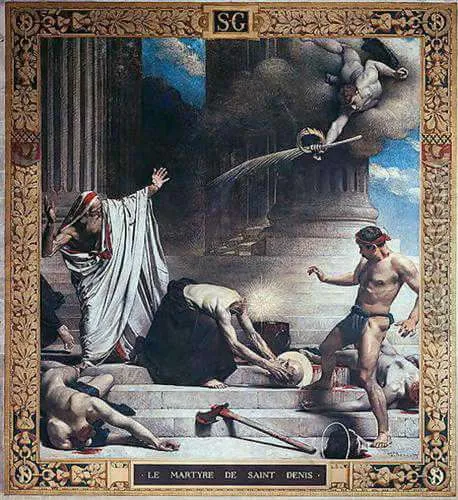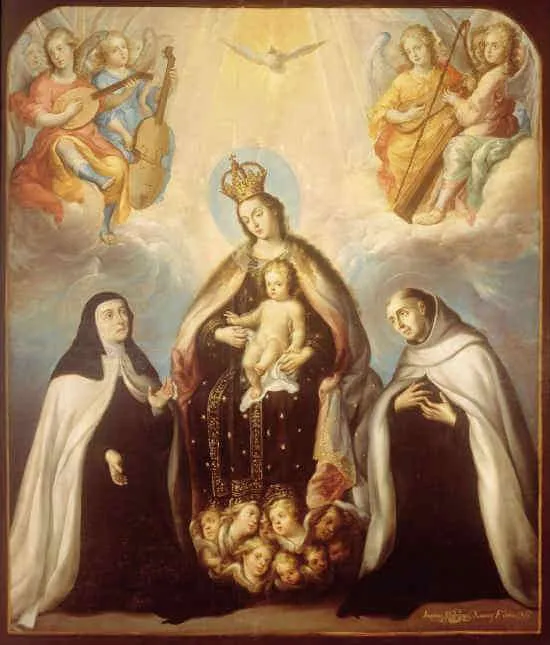1386–1456; Patron Saint of military chaplains, judges, jurists, and lawyers; Canonized by Pope Alexander VIII on October 16, 1690
John was born in Capistrano, in the Kingdom of Naples, modern-day Italy. He came from a wealthy and prominent family. When he was young, his father died and John’s mother educated him at home. When he was older, she sent him to Perugia where he studied civil and canon law under a distinguished legal scholar. John excelled in his studies, and, in 1412, when John was about twenty-six, King Ladislaus of Naples appointed John as the Governor of Perugia. A wealthy nobleman also gave him his daughter in marriage, as well as a large dowry, making John quite wealthy.
At that time, across what is modern-day Italy, there were constant conflicts between powerful noble families and wars between cities and minor kingdoms. As governor, John attempted to root out corruption but was met with strong opposition. Around 1416, the powerful Malatesta family, with the support of others in Perugia, rejected King Ladislaus’ authority over Perugia. When John tried to broker peace, the Malatesta family imprisoned him.
Though imprisonment seems undesirable, it turned out to be the best thing that could have happened to John. His harsh imprisonment meant he was often chained and very poorly fed. He had initially expected King Ladislaus to come to his rescue but was abandoned instead. This suffering led him to think more seriously about his own soul and future, coming to realize that the material things of this world and fleeting temporal power could not compare with the spiritual riches we are all called to attain. Tradition holds that, while in prison, John had a dream or a vision of Saint Francis of Assisi, who instructed him to enter the Franciscan order.
Some historical accounts state that his young wife died while he was in prison; other accounts state that since the marriage was never consummated, it was dispensed. Either way, John decided to sell all of his property to pay the ransom for his release and enter the Franciscans, which he did on October 4, 1416, the Feast of Saint Francis.
The Franciscan superior was cautious about permitting John to join them, given his worldly background, so he tested John’s vocation severely. One story relates that the superior ordered him to ride a donkey through town, sitting backwards and poorly dressed, wearing a cap on his head that listed his many sins in large letters. John joyfully embraced this humiliation, proving his determination and spiritual commitment.
Once clothed in the Franciscan habit, John lived a life of continual prayer and penance. He never ate meat, ate only a scanty meal once a day, slept on the ground only a few hours each night, and mortified his flesh in other traditional ways. Brother John’s prayer life flourished. He pondered the Scriptures, spent long hours before the Blessed Sacrament or a crucifix, and believed that he was providentially given the name “John” because his deepest desire was to become the beloved disciple of the Lord.
Saints often know saints. This was the case of Brother John. His close companion in the order was the future Saint James of the Marches. One of his teachers and mentors within the order was the future Saint Bernardine of Siena, and he would later assist Saint Colette with the reform of the Poor Clares. After studying theology under Father Bernardine and accompanying him on many preaching missions, Brother John was ordained a priest in 1425, at the age of thirty-nine, and spent the next thirty-one years traveling from town to town across northern Italy and throughout northern Europe. Like his mentor, he became exceptionally zealous for the conversion of souls. He railed against immorality, converted entire towns, healed the sick, performed miracles, and preached to hundreds of thousands. One time, he drew a crowd of 126,000 attentive listeners. He drew such large crowds that he had to preach in the public square, the church never being large enough. When he arrived in a town for a mission, normal activity would stop, and surrounding villages would often travel to the mission, which could last for weeks.
Fathers Bernardine and John spread devotion to the Most Holy Name of Jesus. They encouraged the people to revere Jesus’ name by placing the first three Greek letters of His name on their doors: IHS. This new devotion led some within the Church to accuse them of heresy, and they were ordered to Rome to defend themselves. They were acquitted.
The two future saints were also deeply committed to the reform of the Franciscan order, which was continually in need of reform given the high ideals on which it was founded. At that time, the Conventuals were at odds with the Observants. The Conventuals stressed community life and the recitation of the Divine Office, while the Observants added the need for strict poverty. Though this caused ongoing tensions within the order, these reformers persevered in their work and made great strides forward.
Father John became so well respected by Church leadership, including popes, that he was often called upon to act as a papal legate to resolve disputes, was sent on numerous important diplomatic missions, and weeded out heresy wherever it sprung up.
In 1453, when Father John was sixty-seven years old, the Byzantine capital of Constantinople fell to the Ottoman Empire, threatening all of Christian Europe. In response, Pope Callixtus III called on Father John to preach to the people in support of a crusade to defend Europe. By 1456, as many as 50,000 men had joined the crusade, earning Father John the affectionate title of “Soldier Priest.” He personally led the troops and stopped the Turks from advancing on Belgrade, modern-day Serbia. Though the battle was successful, the living conditions were horrendous, and a plague went through the camp. After the battle, Father John became ill and died a few months later.
Saint John of Capistrano was a man who initially appeared to have all that this world had to offer. God saved him from the world through the suffering he endured during his imprisonment. After his eyes were opened, he radically devoted himself to Christ and the salvation of souls.
As we honor this saintly preacher and reformer, reflect upon any ways that God can use your struggles to deepen your faith. Trials can lead us down the path of despair, or prod us to the heights of holiness. Allow Saint John to inspire you so that you, too, will become a truly beloved disciple of our Lord.
Source: https://mycatholic.life/saints/saints-of-the-liturgical-year/october-23—st-john-of-capistrano/








